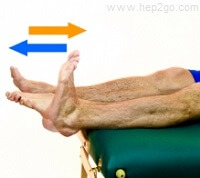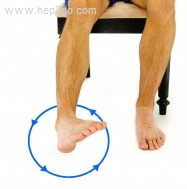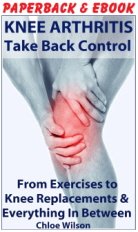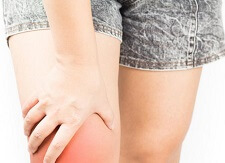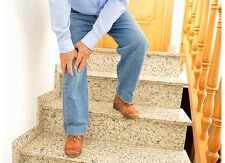- Home
- Knee Surgery
- Knee Replacements
- Exercises
Knee Replacement Exercises
Written By: Chloe Wilson, BSc(Hons) Physiotherapy
Reviewed by: KPE Medical Review Board
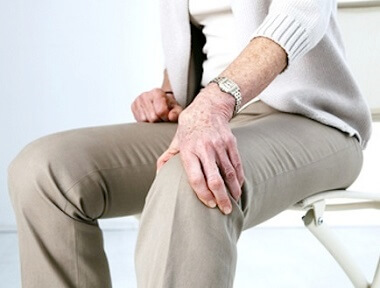
Knee replacement exercises are a vital part of the recovery process to ensure you get the best results from your new knee.
Surgery is just one part of the treatment for knee arthritis - what you do before and afterwards will have a big impact on your recovery.
After a knee replacement, you can get up and about very quickly. As well as practising walking, it is also important to be doing knee replacement exercises to build up the strength of the new knee and get it moving properly.
Here you will find a whole range of knee replacement exercises that are really good to do in the early stages following surgery. They are also suitable to do beforehand in preparation for operation. All these exercises are suitable for both Total Knee Joint Replacements and Partial Knee Replacements (aka uni-knees).
Why Are Knee Replacement Exercises Important?
Knee replacement exercises are a vital part of making a good recovery following a knee replacement.
Knee replacement exercises help to improve:
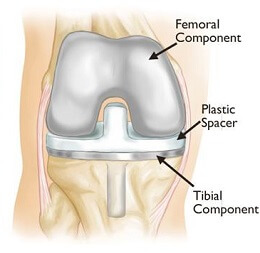
- Flexibility: exercises will loosen up the knee helping it to bend, straighten and rotate more
- Strength: knee replacement exercises help to improve the strength, endurance and control of the knee
- Function: as the strength and flexibility of your knee improve, you will find it gets gradually easier to do daily activities e.g. walking and stairs.
Knee replacement exercises can be started straight away after a knee replacement and will need to be continued for at least three months.
It can also really help to do the knee replacement exercises before you have your surgery, to make sure the muscles are in the best state possible. Starting early can make all the difference to the recovery process.
I have ordered the knee replacement exercises starting with those to do in bed, then in a chair and then the exercises to do standing up so you can progress through as you recover. Choose the ones you find work best for you – keep doing them until they become too easy.
I would also recommend checking out the Exercise Top Tips and Getting The Best Results pages to ensure you achieve the best results from your knee replacement exercises.
Stage 1 Knee Replacement Exercises
These knee replacement exercises are all done lying down so can be started almost immediately after surgery. They will help to loosen up the new knee and reduce the swelling.
1. Foot Pumps
Foot pumps are the best place to start with knee replacement exercises after surgery as they promote good circulation in your leg and prevent Deep Vein Thrombosis (blood clot).
- Lie flat on your back or sitting up with your leg and knee straight
- Pull your foot up towards you, keeping
the rest of your leg straight. Hold for 3 secs
- Then point your toes
down away from you. Hold for 3 secs
- Repeat for about 1 minute every 2-3 hours
You can stop doing this exercise once you are regularly walking around.
2. Ankle Circles
Ankle circles are another good exercise to promote good circulation in your leg to prevent Deep Vein Thrombosis.
- Lying flat on your back or sitting up. Leg and knee straight
- Move your ankles as if you were drawing
circles with your feet. Do this for about 1 minute and then repeat in
the opposite direction
- Repeat for 1 minute in each direction every 2-3 hours
Note: You can stop doing this exercise once you are regularly walking around
3. Quad Clenches
Quad clenches are a great way to maintain and strengthen the Quads without moving the knee and are one of the simplest knee replacement exercises to help you achieve full straightening of the knee.
- Lying flat on your back or sitting up. Leg and knee straight
- Tighten the muscle on the front of the
thigh by pushing your knee down. You should feel your thigh muscles
clench
- Hold for 3 secs
- Repeat 10-20x every 3-4 hours
Variations: If you are struggling to get your knee to straighten fully, place a rolled up towel underneath the ankle so that your leg is lifted slightly on the bed. Then do the exercise as described. Lifting the knee up slightly lets gravity help the knee to straighten
4. Heel Slides - Lying
Heel slides are a really good knee replacement exercise to do in the early stages to loosen your knee up without needing much strength.
- Lying flat on your back or sitting up. Leg and knee straight out on a bed or along the floor
- Slide your heel towards your bottom as far
as you comfortably can, bending your hip and knee. Keep your heel on
the bed/floor
- Hold for 3-5 secs and slowly return to starting position
- Repeat 10-30 times, 2-3x daily. Gradually aim to bend your knee a little more each time
Progression: Carry out the exercise as above but when you’ve bent your knee as much as you can hook a towel over the ankle and pull it towards you to help the knee bend further – you can achieve the same effect by hooking your opposite foot over the ankle and pushing with that leg to gain more knee bending.
Variations: Make the exercise easier by placing a board and/or a plastic bag underneath your foot so you have a slippery surface making it easier to move
5. Short Arcs
Another good strengthening knee replacement exercise to start with as it doesn’t require much knee movement.
- Lie flat on your back or sitting up with your leg horizontal on a flat surface such as a bed. Place a rolled up towel (approx 10cm diameter) under the knee
- Pull your toes towards you and clench you
thigh muscles. Slowly lift your foot up off the bed until your knee is
straight (keep your knee resting on the towel)
- Hold for 3-5 secs and
slowly lower
- Repeat 10-30 times, 2-3x daily
Progression: 1. Increase the size of the towel under the knee
2. Add a weight e.g. by wearing a shoe, or using a light ankle weight. Progress further by using a heavier weight
6. Straight Leg Raise
The straight leg raise is an excellent knee replacement exercise for strengthening the quads without having to bend the knee. It also makes getting in and out of bed easier.
NB Not appropriate if you have a history of back problems
- Lie flat on your back with your leg and knee straight
- Pull your toes towards you and
tighten/clench the muscle on the front of the thigh, locking your knee
straight
- Lift your foot up about 6 inches off the bed. Hold for 3-5
secs and slowly lower. Ensure your knee stays straight the whole time
- Repeat 10-20 times, 2x daily
Progression: Add a weight e.g. by wearing a shoe, or using an ankle weight
Top Tip: You might find that when you first start doing this knee replacement exercise that your knee bends slightly when you first lift the leg - this is due to weakness in the quads. Keep going - it will come!
Stage 2 Knee Replacement Exercises
You should be able to start these seated knee replacement exercises as soon as you are able to get out of bed.
1. Long Arcs
Long arcs are a great way to strengthen the quads and increase knee mobility. They are a great knee replacement exercise to do anytime you are sitting for prolonged periods (30mins+) to stop the knee from getting stiff.
- Sit on a firm chair with your knee bent and your foot on the floor
- Lift your foot up and straighten your knee as much as possible. Hold for 3-5 secs and slowly lower
- Repeat 5-20 times, 3x daily
Progression: Strengthen further by adding a weight either by wearing a shoe or ankle weights.
2. Heel Slides - Sitting
Heel slides in a chair are one of the best knee replacement exercises for regaining knee flexion.
- Sit on a dining chair with your knee bent and your foot on the floor
- Slide your foot backwards on the floor as far as comfortable so you are bending the knee more. Hold for 3-5 secs
- Repeat 10-25x, 3x daily
Progression: 1. Hook your other foot around the front of the ankle and push backwards with it to further bend your knee
2. Once you have slid your heel back as far as you can, raise
yourself up on your chair using your arms and slide you bottom forwards
keeping your foot still. You will find this makes your knee bend even
more.
3. Buttock Clenches
A simple, yet effective exercise to maintain and strengthen the Glutes (buttocks) without having to move the knee. If the glutes are weak, more force goes through the knee, so glutes strengthening should always form part of knee replacement exercises.
- Lie down or sit in a chair
- Clench your buttocks together and hold for 3 seconds. You should feel yourself rise up slightly
- Repeat 10-20x every 3-4 hours
4. Knee Marching
This is essentially four knee replacement exercises in one - it strengthens the quads, improves knee mobility, improves circulation and loosens up the legs after you’ve been sitting for a while.
- Sit in a chair with your feet on the floor
- March your legs up and down one at a time, lifting your knee and foot up and then back down
- Repeat for about 1 minute, 2x daily and any time you are sitting for more than 20 mins to stop your knee getting stiff
Stage 4 Knee Replacement Exercises
Once you are feeling confident on your feet, you can start these standing knee replacement exercises. Hold onto something stable like a table or the wall for some balance.
1. Kick Backs
Kick backs help strengthen the knee and also help improve flexibility – both vital components of knee replacement exercises rehabilitation.
- Stand up straight holding on to something stable e.g. chair or table
- Lift your foot up as far as you can towards your bottom, bending the knee. Hold for 3-5 secs
- Repeat 5-25 times, 2x daily
Progression: Add a weight e.g. shoe or ankle weight
Top Tips: 1. Don’t bend forwards - keep your body upright
2. keep your knees in line with each other- don’t let your thigh come forwards.
2. Heel Raises
Heel raises help to strengthen the calf muscles which provide support the knee. The calf muscles often get forgotten with knee replacement exercises.
- Stand with your feet slightly
apart, weight equally distributed, holding onto something solid for
balance e.g. kitchen work surface or wall
- Rise up onto your toes lifting your
heels as high as possible. Keep your body upright (don’t bend
forwards)
- Hold for 3-5 secs and slowly lower
- Repeat 10-30 times, 2x daily
What Else Can Help?
Check Out Our Book
All the info you need about knee arthritis, top tips, exercises & loads more.
Rated 4.4/5
Find Out More
Once you can happily do all of these knee replacement exercises, you are ready to progress onto more advanced exercises.
If you want to know more about knee replacements, including information on knee replacement recovery and frequently asked questions, use the links.
Remember, you will need to continue with these exercises for a good few months to get the most benefit. You will gradually be able to reduce how often you do them, but don't stop your knee replacement exercises until you have regained full strength, movement and function in your knee.
Page Last Updated: 11/01/23
Next Review Due: 11/01/25
Related Articles
Knee Swelling
March 12, 2023
Knee Pain On Stairs
January 16, 2023
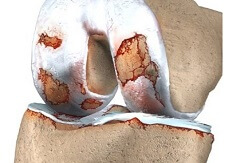
Best Diet For Arthritis
January 11, 2023
References
1. BMC Musculoskeletal Disorders: What is the evidence to support early supervised exercise therapy after primary total knee replacement? A systematic review and meta-analysis. Sattler L, Hing W, Vertullo C. January 2019.
2. Ontario Health Technology Assessment Series: Physiotherapy rehabilitation after total knee or hip replacement: an evidence-based analysis. Medical Advisory Secretariat. June 2005
3. Guy's & St Thomas' NHS Foundation Trust: Physiotherapy advice following total knee replacement surgery. Guy's & St Thomas' UK. February 2013
